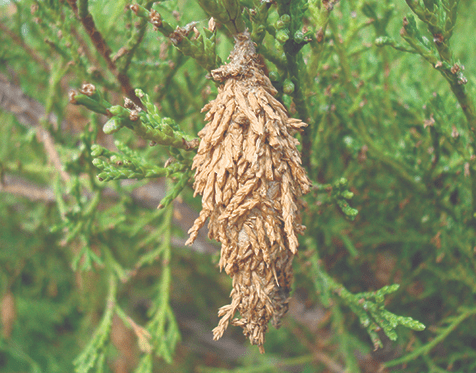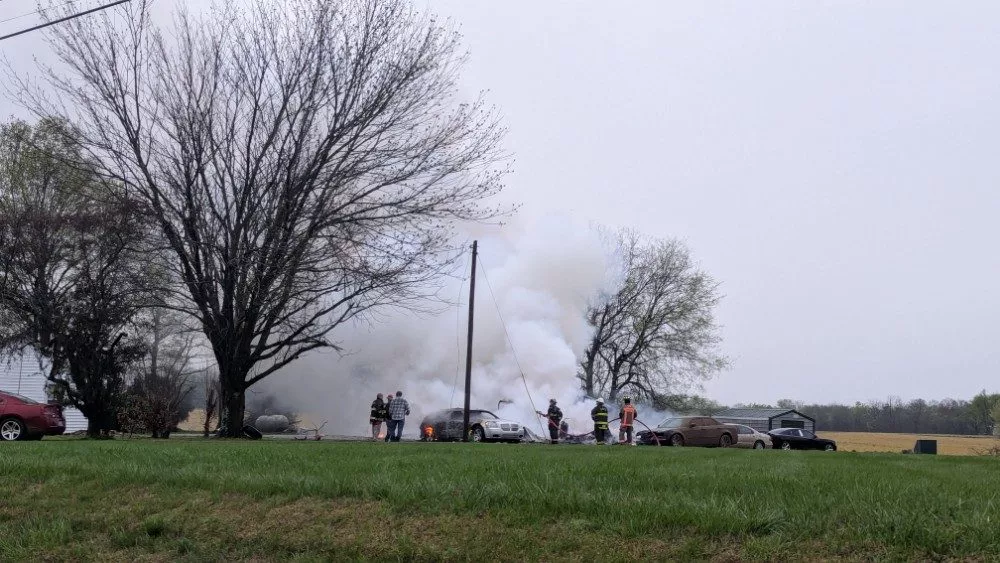
Bagworms, a major pest of evergreen trees and shrubs such as juniper, arborvitae, cedar, pine, and spruce, are starting to hatch and feed. When bagworms are numerous they strip the foliage from plants ultimately leading to their decline. The key is to continue to check your landscape plants for bagworms before they have a chance to defoliate the plant. Many other woody landscape plants, including cypress, willow, honeylocust, apple, maple, rose, boxelder, and birch, can be attacked by this pest but are rarely damaged seriously.
Bagworms are larvae that cover themselves with pieces of leaves and bark from the plant while they feed. As you observe your shrubs you may find egg sacs, which are spindle-shaped bags about 1.5 to 2 inches long, hanging from the limbs. Bags, which are less than one-quarter inch long, have a larva inside. You can see these smaller bags move as the larvae eat. The larva in the bag, or bagworm, is the immature stage of a moth. Only the males develop into moths capable of flight. The adult female is grub-like and remains inside the bag until just before she dies. The adult female lays her eggs inside the bag that was once her home and these eggs overwinter until late May or early June, when they hatch.
In late spring, small, blackish larvae crawl out from the bottom of the bag in search of food. By using silk and bits of leaves, bark, or twigs, the larvae build a small protective bag around their body. The blackish larvae, camouflaged with bits of the plant, look like part of the branch. They are usually unnoticed unless they are feeding or moving. As the larvae grow, they add-on to the bag making it large enough to allow them to retreat into the bag when disturbed.

Bagworm larvae have two ways of spreading from plant to plant. Very young larvae may release a small amount of silk as they emerge from the bag which carries them relatively long distances to another plant by air currents (a phenomenon sometimes called “ballooning”). Larger larvae move short distances by crawling.
Around early September, the bags reach their maximum size of 1.5 to 2 inches long. At this time, the larvae permanently suspend their bags from twigs with bands of silk. The larvae transform into the pupa, or resting stage, prior to becoming an adult. Adults emerge from the pupal stage in late September. The creamy white females do not have wings or legs and appear grub-like. They remain in the bag. Adult males are black, furry, clear-winged moths with about a 1-inch wingspan. They are active fliers and move in search of females. The females attract the males for mating by releasing a pheromone. A fertilized female can lay between 500 to 1000 eggs, which fill the bag, forcing her toward the bottom. When finished, she drops from the bag and soon dies. The eggs remain in the bag until they hatch the following May, completing the cycle for another year.
There are several options when managing bagworms. If the bags are relatively small in number and can be reached easily, pick them off the plant, squash the bag and dispose of it. This method of control can be used anytime. If your bagworm problem is limited to only a few small trees or shrubs, hand removal of the bags during the fall through the spring may be sufficient to reduce overwintering eggs and minimize the problem.
When many small bagworms are attacking evergreens, insecticides are needed to prevent serious damage to the plant. When using an insecticide, the foliage should be thoroughly wet. Apply insecticides before the bags are a half-inch long, usually in late June or early July. If the bag is larger than a half-inch, control with an insecticide is very poor. Recommended insecticides include carbaryl (Sevin), Cyfluthrin (Bayer Multi-Insect Killer) and acephate (Orthene Tree and Shrub Insecticide). Read the label to make sure the product is labeled for your plant to avoid injury. Also, follow the instructions on the label for applying the product.
— Kelly Jackson, Christian County Extension Agent



